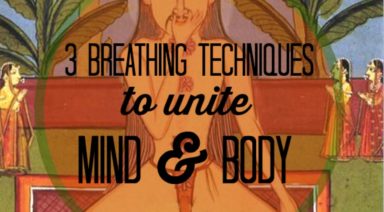The How’s and Why’s of Meditation

Silence befalls an ancient temple as rows of robed monks settle themselves, body, and mind. Eyes closed, legs pulled up into a lotus position, the eye of the mind turns inward. For hours they remain; their minds disciplined to ponder like this for long periods of time. This is not a feat for the average person.
Perhaps when people utter the word meditation, this image stirs in the imagination. Indeed, meditation has been a part of spiritual and religious practice for as long as mankind has been recording history. It does take years of steady practice to hold such a state of mind for hours at a time. However, meditation is something that is not only easily accessible to anyone, but you may already be doing it without realizing it.
Meditation simply means to think, contemplate or ponder. Throughout the world, it holds many different names, but the idea is the same: to enter a state of mind where it is easy to focus upon one thing. If you have ever found yourself daydreaming for any length of time, you are meditating. If you found yourself captivated by repetitive motion, the wheels and the sound of a passing train, for example, you were lulled into a meditative state. The same is true when you are reading a book and lose track of the time.
It is perfectly natural for your mind to slip into a trance and let the present moment go. When one intentionally practices meditation they engage in a discipline of training their mind and body. This practice can be applied to many different goals: relaxation, contacting spirits, building energy, enlightenment, self-contemplation, or empty mind, just to name a scant few.
A simple meditation that anyone can do is mindfulness meditation. In the place you are at this very moment, just look around. Notice everything that surrounds you. Pay attention to colors, textures, shapes, and lines. Then listen to all the sounds and pay close attention to every subtle nuance. Notice the smells, the air temperature, and any sensory information you are receiving. Do not judge what you are perceiving; do not attempt to make any sense of it. Just for the moment, be aware of your breathing, the feeling of your feet touching the floor, and bear witness to all that is surrounding you. Allow yourself simply to observe and become a part of the moment. This simple meditation can help you, in many ways.
There are many physical health benefits of meditation: reduction in stress and anxiety-lowering stress hormones such as cortisol and adrenaline. These stress hormones can bog down the immune system making it harder to fend off illness. In addition, elevated stress levels have additional negative effects throughout the body. Practicing a relaxation meditation, regularly, may reduce or reverse these negative effects. As always, consult your doctor for any medical advice pertaining to you.
Make sure you consult the doctors of all time periods, too, from long-ago civilizations to the present day. Timeless techniques from the Buddhists are just as viable today as they were hundreds of years ago. Yoga experts teach you both relaxation and movement meditations. Experts from scientific and business fields weigh in on their experience as to the benefit of meditation. No matter what you are seeking, or if you are looking to augment your practice, there is something to be gained.
No matter how you choose to do it, meditation can benefit all areas of your life. You can create your own peaceful sanctuary within your own being. Perhaps you want to improve your performance at work or in sports. In the depths of your mind, you may find your own inner truth and life’s purpose. Maybe you are just seeking to improve the performance of your brain and mind. No matter how you approach it, or why you choose to meditate, there is no doubt that a regular practice can have overarching benefits throughout every aspect of your life.

7 Ways to Ease Into Meditation

Meditation is for everyone: monks in Tibet, yogis, corporate lawyers, gardeners, the rich, poor, young, and old. We may all approach life differently but in meditation, we are all doing the same thing: quieting the mind and looking within. In a society where information is so readily available, we often look to other sources for opinions and advice. It’s more important than ever to make meditation a priority. Our bodies and minds are our greatest compasses in life. They will always tell us if something we are doing is good for us or not; we just have to stop for a moment to look, feel, and listen from within.
Enter the Here & Now Through Meditation
Whether you’re looking to cultivate more authenticity, increase happiness, improve relationships, or reduce stress, all of these things are accessible to you through the practice of meditation.
Sign up for Here & Now: A Beginner’s Guide to Meditation and fundamentally change your life.
Here are 7 Ways to Ease Into a Meditation Practice:
1. Give yourself some “soft time” before meditation
Often, the moment you try to quiet the mind it will wander in a thousand different directions. “I forgot to do this today… the kids have a big test tomorrow…my husband forgot to take out the trash…there is a sale at the grocery store…I don’t have time to sit here doing nothing…” Give yourself a few minutes to let the mind do this and then ask it to quiet down. Truly ask it; it’s usually responsive.
2. Compose a to-do list
If after letting your mind wander and asking it to quiet down, you are still unable to reach a place of stillness, write those pesky things down, and acknowledge them. Sometimes that’s all thoughts need— acknowledgment.
3. Start a ritual
Meditation can be done anywhere at any time. It can be done in the middle of the subway during rush hour or in the middle of a meeting with your boss (I don’t recommend the latter). I’ve found, though, that training the mind to quiet down in a specific setting prepares it to settle down with less effort. Light candles have chamomile tea, take a bubble bath. Signal to your mind that it’s time to relax.
4. Learn to observe
We are not our thoughts. We have our thoughts. Try to detach yourself and simply watch them go by. View them in a cloud or a bubble and allow them to float away.
5. Focus on the breath
I know, you have heard this a million times. But it works! The best lesson I received in meditation is to focus on the pause between inhales and exhales. The four stages of breath give the mind something to focus on and connect us to our life force. You can focus on the breath and reduce your stress in just 15 minutes with Seize the Day! prior to even leaving the house. It’s lovely.
6. Do yoga
Yoga flows can become a moving meditation. Yin yoga can bring your mind and body into stillness. Kundalini can prepare the breath. Any type of yoga can open the mind and body to meditation. You can’t lose.
7. Think Positive Thoughts
Finally, if you’re having a crazy day and can’t get your mind to settle down, it’s OK. Think positive thoughts. There are days when meditation is easy, days when it takes a little longer to become still, and days when it just doesn’t want to happen. I used to become annoyed with myself if I couldn’t stop the endlessness of my thoughts, but that defeats the purpose. On those days, I ask my mind to come up with as many positive words as it can. Joy, peace, serenity, gratitude, etc. After even just a few minutes of doing this, I guarantee you will be in a calm, peaceful place.
































